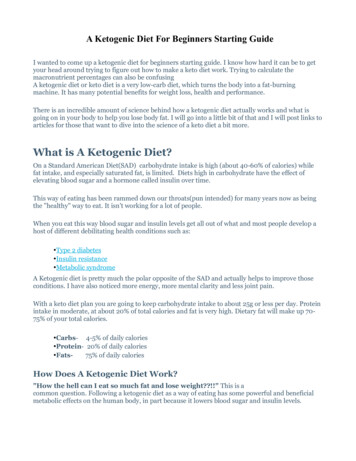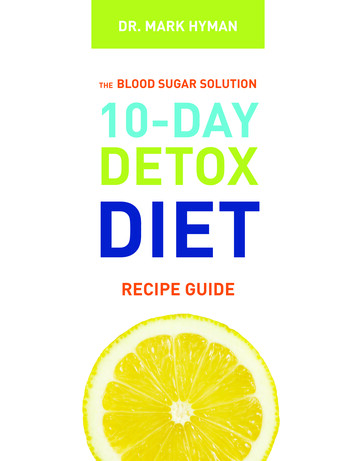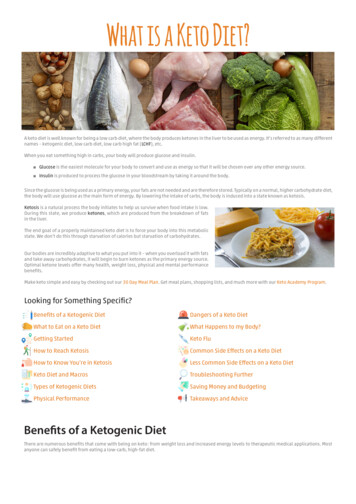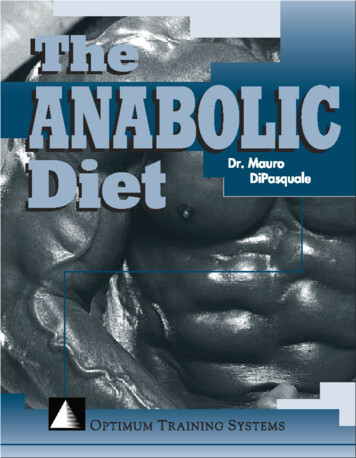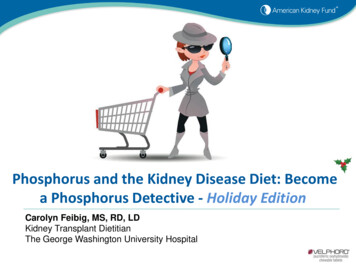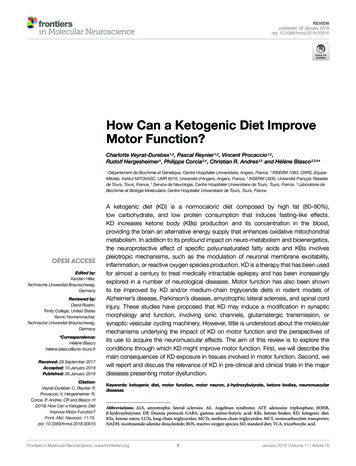
Transcription
REVIEWpublished: 26 January 2018doi: 10.3389/fnmol.2018.00015How Can a Ketogenic Diet ImproveMotor Function?Charlotte Veyrat-Durebex 1,2 , Pascal Reynier 1,2 , Vincent Procaccio 1,2 ,Rudolf Hergesheimer 3 , Philippe Corcia 3,4 , Christian R. Andres 3,5 and Hélène Blasco 2,3,5*1Département de Biochimie et Génétique, Centre Hospitalier Universitaire, Angers, France, 2 INSERM 1083, CNRS, EquipeMitolab, Institut MITOVASC, UMR 6015, Université d’Angers, Angers, France, 3 INSERM U930, Université François Rabelaisde Tours, Tours, France, 4 Service de Neurologie, Centre Hospitalier Universitaire de Tours, Tours, France, 5 Laboratoire deBiochimie et Biologie Moléculaire, Centre Hospitalier Universitaire de Tours, Tours, FranceEdited by:Karsten Hiller,Technische Universitat Braunschweig,GermanyReviewed by:David Ruskin,Trinity College, United StatesYannic Nonnenmacher,Technische Universitat Braunschweig,Germany*Correspondence:Hélène Blascohelene.blasco@univ-tours.frReceived: 29 September 2017Accepted: 10 January 2018Published: 26 January 2018Citation:Veyrat-Durebex C, Reynier P,Procaccio V, Hergesheimer R,Corcia P, Andres CR and Blasco H(2018) How Can a Ketogenic DietImprove Motor Function?Front. Mol. Neurosci. 11:15.doi: 10.3389/fnmol.2018.00015A ketogenic diet (KD) is a normocaloric diet composed by high fat (80–90%),low carbohydrate, and low protein consumption that induces fasting-like effects.KD increases ketone body (KBs) production and its concentration in the blood,providing the brain an alternative energy supply that enhances oxidative mitochondrialmetabolism. In addition to its profound impact on neuro-metabolism and bioenergetics,the neuroprotective effect of specific polyunsaturated fatty acids and KBs involvespleiotropic mechanisms, such as the modulation of neuronal membrane excitability,inflammation, or reactive oxygen species production. KD is a therapy that has been usedfor almost a century to treat medically intractable epilepsy and has been increasinglyexplored in a number of neurological diseases. Motor function has also been shownto be improved by KD and/or medium-chain triglyceride diets in rodent models ofAlzheimer’s disease, Parkinson’s disease, amyotrophic lateral sclerosis, and spinal cordinjury. These studies have proposed that KD may induce a modification in synapticmorphology and function, involving ionic channels, glutamatergic transmission, orsynaptic vesicular cycling machinery. However, little is understood about the molecularmechanisms underlying the impact of KD on motor function and the perspectives ofits use to acquire the neuromuscular effects. The aim of this review is to explore theconditions through which KD might improve motor function. First, we will describe themain consequences of KD exposure in tissues involved in motor function. Second, wewill report and discuss the relevance of KD in pre-clinical and clinical trials in the majordiseases presenting motor dysfunction.Keywords: ketogenic diet, motor function, motor neuron, β-hydroxybutyrate, ketone bodies, neuromusculardiseasesAbbreviations: ALS, amyotrophic lateral sclerosis; AS, Angelman syndrome; ATP, adenosine triphosphate; βOHB,β-hydroxybutyrate; DP, Deanna protocol; GABA, gamma amino-butyric acid; KBs, ketone bodies; KD, ketogenic diet;KEs, ketone esters; LCTs, long-chain triglycerides; MCTs, medium-chain triglycerides; MCT, monocarboxylate transporter;NADH, nicotinamide adenine dinucleotide; ROS, reactive oxygen species; SD, standard diet; TCA, tricarboxylic acid.Frontiers in Molecular Neuroscience www.frontiersin.org1January 2018 Volume 11 Article 15
Veyrat-Durebex et al.Ketogenic Diet in Motor Functionmitochondrial renewal. Finally, KD might have potential, indirectroles, such as effects on neurotransmission, oxidative stress,and inflammatory mechanisms. Figure 1 sums up the cellularmechanisms induced by KD.INTRODUCTIONThe KD, tested for the first time in 1921 for intractable childhoodepilepsy, is based on a normocaloric, high fat, adequate-protein,and low-carbohydrate diet resulting in the production of KBs(Keene, 2006). Different types of KDs have been described. Theclassic ketogenic therapy is based on a diet providing 90% ofcalories from long-chain fatty acids, a restricted protein portion(1 g/kg/day), and minimal carbohydrates. Traditionally, thediet is comprised of four parts fat, mainly LCTs, for one partcarbohydrates and proteins. The ratio can be modified to 3:1, 2:1,or 1:1, respectively, similar to the modified Atkins diet (Kossoffet al., 2003). The MCTs diet is also proposed with 60% of caloriesfrom octanoate and decanoate that are more ketogenic than LCTs(Huttenlocher, 1976). The last alternative to a ketogenic therapyis the low glycemic index diet characterized by higher amounts ofcarbohydrates with low glycemic index (Coppola et al., 2011).Despite the underlying, unclear mechanisms, KD isconsidered to be a “neuroketotherapeutic” (Koppel andSwerdlow, 2017). The efficacy of KD in drug-resistant epilepsy inchildren and adult patients has been proven for almost a century(Stafstrom and Rho, 2012) with more than 50% reduction inseizures for intractable childhood epilepsy (Lefevre and Aronson,2000). KD has progressively gained interest for the treatmentof other diseases as a stand-alone metabolic therapy or as partof a general, therapeutic strategy (Paoli et al., 2014). Variousmechanisms have been advocated to explain the anti-convulsiveand neuroprotective effects of KD, such as a decrease in glucosemetabolism due to the increase in lipid oxidation, a reductionin ROS production, an increase in ATP, and modulations ofneuronal membrane excitability, inflammation, oxidative stress,and mitochondrial function (Gasior et al., 2006; Elia et al., 2017).Thus, KD is expected to be highly relevant in diseasescharacterized by any of these mechanisms. For example, motordysfunction, involving the nervous system, muscles and tendons,observed in neuromuscular diseases or as a component of variouspathological conditions, may benefit from such treatment. Asnon-pharmacological management is rarely considered and littledata has been published on dietary therapies, we have focused ourreview on the potential benefit of such KD therapies on motorfunction. Firstly, we will describe the neuroprotective effects ofKD, especially in tissues involved in motor function. Secondly, wewill present and discuss pre-clinical and clinical trials of KD fordiseases presenting a motor dysfunction. Finally, we will presentsome perspectives of other new therapeutics, based on metabolicfactors targeting energy metabolism.Metabolism SwitchKetogenic diet has a high impact in tissues with a highenergy requirement and with challenges from modificationsin metabolic substrates, such as the neuromuscular system.The brain represents 2% of one’s body weight but consumesabout 20% of the body’s energy stores (Belanger et al.,2011) in order to fuel the processes of neurotransmitterproduction/recycling, vesicular trafficking, maintenance of iongradients for the propagation of action potentials, and memory,to name a few. Similarly, in the resting state, 20% of theenergy expenditure is devoted to muscle (Gallagher et al.,1998), and it can largely increase with muscle contractions,for example for transforming organelles, enzymatic activities,intracellular signaling, and transcriptional responses (Coffeyet al., 2007).Ketogenic diet promotes KBs (acetoacetate andβ-hydroxybutyrate) production in the liver from acetyl-CoAformed during mitochondrial β-oxidation of fatty acids. Some ofthe acetyl-CoA enters the TCA cycle, and the excess is used toform acetoacetate, which could be converted to βOHB by βOHBdehydrogenase (BDH) enzyme or spontaneously converted toacetone (Newman and Verdin, 2014). KBs are transported toother tissues (brain, muscle, and heart) through the blood andused as fuel, especially in the brain (Kunnecke et al., 1993; Raeet al., 2012; Achanta and Rae, 2017). It has also been reportedthat astrocytes can produce KBs from fatty acids (Auestad et al.,1991) and leucine (Bixel and Hamprecht, 1995). Astrocytespresent the same preference for fatty acids (rather than glucose)as metabolic fuel and have enzymatic machinery similar to thatof cultured hepatocytes (Guzman and Blazquez, 2001).β-Hydroxybutyrate and acetoacetate enter cells via the MCTand provide an alternative substrate for brain. Several studiesseem to highlight that KBs are a preferred carbon source undercertain conditions (LaManna et al., 2009; Lund et al., 2011;Zhang Y. et al., 2013; Chowdhury et al., 2014; Valente-Silva et al.,2015), but these finding remain controversial (McKenna, 2012;Achanta et al., 2017). Some studies evoked that KBs provide moreefficient energy source than glucose, even for the brain. Theyare metabolized faster than glucose and bypass the glycolyticpathway by directly entering the TCA cycle, whereas glucose hasto first undergo glycolysis (Veech et al., 2001; LaManna et al.,2009; Elamin et al., 2017). Consequently, KBs lead to a decreasein glycolytic ATP generation and an increase in ATP generationby mitochondrial oxidation (Kim et al., 2010; Steriade et al.,2014; Hyatt et al., 2016). Moreover, Elamin et al. (2017) showedthat whereas both glucose and KBs produce two molecules ofacetyl-CoA, glucose reduces four molecules of NAD and KBsreduce either one (for conversion of BOHB in acetoacetate),or none (for conversion of acetoacetate in acetyl-CoA) duringacetyl-CoA synthesis. KD is associated with a coordinatedupregulation of hippocampal genes encoding metabolic andmitochondrial enzymes (Bough et al., 2006). KD also leadsPROTECTIVE EFFECTS OF KD ON THENEUROMUSCULAR SYSTEMThe effects of KD administration on the neuromuscular systemcome through different mechanisms. For one, KD can directlyinduce metabolic shifts due to the high blood levels of KBs andto the restriction of carbohydrate intake (Danial et al., 2013).KD can also modify nutrient-integrating pathways, such as themTOR pathway, involved in autophagy and mitophagy-relatedFrontiers in Molecular Neuroscience www.frontiersin.org2January 2018 Volume 11 Article 15
Veyrat-Durebex et al.Ketogenic Diet in Motor FunctionFIGURE 1 Schematic illustration of the main cellular mechanisms in the KD on the neuromuscular system. The main energetic substrate of the nervous system isglucose, but alternative substrates exist, for instance pyruvate (Gonzalez et al., 2005), lactate (Dienel, 2012), and βOHB (Kunnecke et al., 1993; Achanta and Rae,2017). Most KBs (β-hydroxybutyrate and acetoacetate AcAc) used by the brain are supplied by the liver, but they can also be synthesized in astrocytes, which arethe only cell type in the brain capable of oxidizing fatty acids (FA). KBs enter cells via the monocarboxylate transporter (MCT). Then, acetyl-CoA can enter the TCAcycle to produce ATP. KD leads to a decrease in glycolytic ATP generation and an increase in ATP generation in mitochondria. FA, fatty acids; CPT1, carnitinepalmitoyltransferase 1; AcAc, acetoacetate; βOHB, β-hydroxybutyrate; OxPHOS, oxidative phosphorylation; TCA cycle, tricaboxylic acid cycle; ATP, adenosinetriphosphate; BDH, beta-hydroxybutyrate dehydrogenase; SCOT, succinyl-CoA:3-ketoacid coenzyme A transferase; PDH, pyruvate dehydrogenase; GLUT, glucosetransporters; UCP, uncoupling proteins; ROS, reactive oxygen species; PCr/Cr, phosphocreatine/creatine; GABA, gamma-aminobutyric acid.to fatty acid-mediated activation of peroxisome proliferatoractivated receptor α (PPARα) that inhibits glycolysis and fattyacid synthesis, promotes the transcription of ketogenic enzymes,promoting mitochondrial and peroxisomal fatty acid oxidation(Cullingford, 2004). Moreover, the cellular energy reserve isincreased as a result from a higher phosphocreatine/creatine ratioin the hippocampal tissue (Bough et al., 2006).Taken altogether, neurons possess a better resistance andadaptive ability to metabolic stress and challenges, both havingto do with a more energy-efficient fuel source and a largermitochondrial load based on a stimulation of mitochondrialbiogenesis (Bough et al., 2006; Srivastava et al., 2012, 2013).requirement of the brain, might increase ROS productionthrough the mitochondrial electron transport chain (MoralesAlamo and Calbet, 2014). Despite possible, positive effects of ROSproduction on mitochondrial adaptations (Ji et al., 2016), thedeleterious effect of oxidative stress must be controlled, primarilyin the brain (Islam, 2017). Veech (2014) reported a decrease infree radical production through the reduction of coenzyme Q,induced by KBs. Importantly, a decrease in oxidative stress and anincrease in mitochondrial glutathione and glutathione peroxidaseactivity were observed during KD, which may protect tissuesfrom injury (Ziegler et al., 2003; Bough et al., 2006; Staffordet al., 2010; Stafstrom and Rho, 2012; Greco et al., 2016). AsROS generation partially reflects mitochondrial function, thedecrease in ROS production may be a result of an effect onNADH oxidation or on calcium overload (Kim et al., 2007;Maalouf et al., 2007). Some authors have described that, in KD,Antioxidant EffectsThe accumulation of certain metabolites and hypoxia producedduring muscular contractions, along with the high energeticFrontiers in Molecular Neuroscience www.frontiersin.org3January 2018 Volume 11 Article 15
Veyrat-Durebex et al.Ketogenic Diet in Motor FunctionNF-κB and cytokines, such as IL-6 and TNFα (Cullingford,2004; Nandivada et al., 2016). βOHB inhibits the NLRP3inflammasome, which controls the activation of caspase-1 andthe release of the pro-inflammatory cytokines, IL-1β and IL-18(Youm et al., 2015; Goldberg et al., 2017).there is an elevated production of mitochondrial uncouplingproteins, thereby decreasing ROS levels probably via fatty acidsfound elevated in treated patients (Fraser et al., 2003; Sullivanet al., 2004; Maalouf et al., 2007). Carbohydrate restriction alsoinduces stress res
diet is comprised of four parts fat, mainly LCTs, for one part carbohydrates and proteins. The ratio can be modified to 3:1, 2:1, or 1:1, respectively, similar to the modified Atkins diet (Kossoff et al.,2003). The MCTs diet is also proposed with 60% of calories from octanoate and decanoate that are more ketogenic than LCTs (Huttenlocher .
